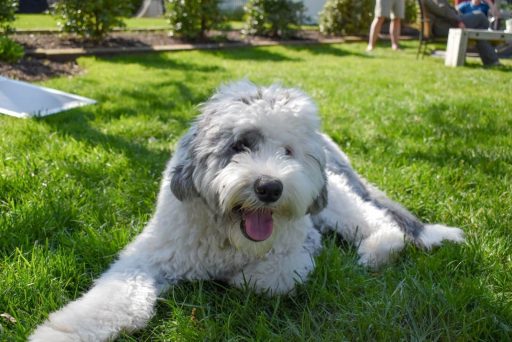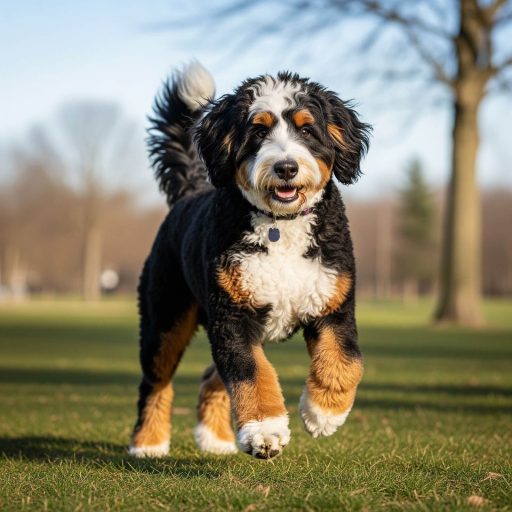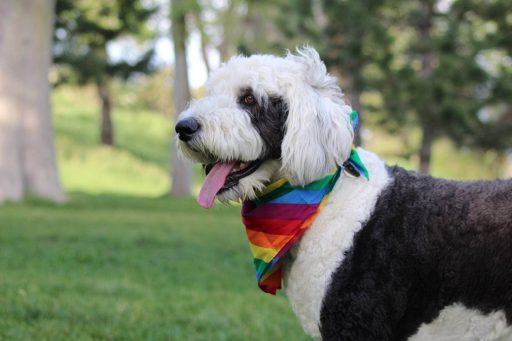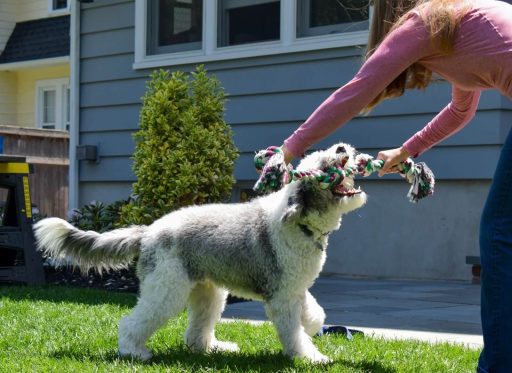Bernedoodles and Sheepadoodles are both friendly and affectionate dogs that love to play and cuddle. But even though they seem similar, there are some differences that might make one a better choice for you.
If you’re trying to decide between a Bernedoodle and a Sheepadoodle, this guide is here to help. Let’s find out which one of these fluffy dogs would be the best fit for your family and home.
🐶 Key Takeaways
- Sheepadoodles are more energetic and need significantly more daily exercise than Bernedoodles
- Bernedoodles are adaptable to various lifestyles, while Sheepadoodles need active homes with space.
- Both breeds come in various sizes, allowing you to choose the best fit.
- Sheepadoodles need more frequent and intensive grooming than Bernedoodles.
Bernedoodle vs Sheepadoodle: Key Differences
Breed Overview and Origins
What Is a Bernedoodle?

Bernedoodles are a charming mix of Bernese Mountain Dog and Poodle, known for their sweet, family-oriented nature and minimal shedding. Their unique tri-colored coats and loving personalities make them a popular pet option, especially for homes with children. They easily fit into various lifestyles, as long as they get enough play and love.
👉 Best for: Families with children, singles, or those looking for a loyal and affectionate dog who enjoys both play and relaxation.
What Is a Sheepadoodle?

Sheepadoodles are a captivating hybrid, a mix of Old English Sheepdog and Poodle, recognized by their black and white coats and affectionate personalities.
They bring together the fun-loving, playful side of the Old English Sheepdog and the smart, low-shedding qualities of the Poodle, which makes them energetic and fun-filled companions.
👉 Best for: Active individuals or families who can provide them with plenty of exercise and mental stimulation. They also thrive in homes with large yards or access to open spaces.
Sheepadoodle vs. Bernedoodle: Size

The size of a Bernedoodle and Sheepadoodle largely depends on the size of their Poodle parent. Because Poodles come in standard, miniature, and toy varieties, you’ll find Bernedoodles and Sheepadoodles in a range of sizes, too.
This means you can choose the perfect-sized doodle to fit your lifestyle, whether you’re looking for a small lap dog or a larger companion for outdoor adventures.
Bernedoodles come in 3 distinct sizes
- Standard Bernedoodle: The largest size, typically standing 23-29 inches tall and weighing between 70-90 lbs.
- Miniature Bernedoodle: A medium-sized option, usually standing 18-22 inches tall and weighing 25-49 lbs.
- Tiny Bernedoodle: The smallest variety, standing 12-17 inches tall and weighing 10-24 lbs.
Sheepadoodles are also available in different sizes:
- Standard Sheepadoodle: They stand 16-27 inches tall and weigh 60-80 lbs.
- Miniature Sheepadoodle: A smaller option, typically standing 12-16 inches tall and weighing 25-40 lbs.
Bernedoodle v. Sheepadoodle: Coat

Both Bernedoodles and Sheepadoodles inherit their low-shedding and hypoallergenic coats from their Poodle parent. However, their coat textures and grooming needs can vary.
Bernedoodle
Bernedoodles typically have a wavy or curly coat with a texture that can range from soft and fluffy to more wiry.
- Shedding: Minimal to low shedding – a good choice for those with allergies
- Grooming Needs: Moderate to high – requires regular brushing to prevent matting and professional grooming every 6-8 weeks.
Sheepadoodle
Sheepadoodles typically have a fluffy, shaggy coat that can be wavy or curly.
- Shedding: Low-shedding, but may require more frequent brushing than a Bernedoodle due to their thick coat.
- Grooming Needs: High – needs regular brushing and professional grooming every 4-6 weeks to prevent mats and tangles
Bernedoodle vs. Sheepadoodle: Training and Exercise

Both Bernedoodles and Sheepadoodles are intelligent and eager to please; however, their exercise needs differ due to their varying energy levels.
Bernedoodle
Bernedoodles need about one hour of activity every day, including walks, playing fetch, or exploring a new park. Because they’re smart, they pick up training quickly, especially when you reward them with praise and treats.
To keep their minds busy, try puzzle toys, hide-and-seek games, or even teach them fun tricks like rolling over or giving a high-five.
🐶 Bernedoodle Training Tips
- Start with basic obedience commands like “sit,” “stay,” and “come.”
- Use positive reinforcement, such as treats and praise.
- Keep training sessions short and fun so they don’t get bored.
- Be patient and consistent with the training.
Sheepadoodle
Sheepadoodles have a lot of energy and need at least 90 minutes of exercise every day, like running, hiking, or playing fetch. It’s important that you train them and socialize with other dogs and people when they’re puppies.
To prevent boredom, provide them with mental challenges through interactive toys, puzzle games, and engaging training routines.
🐶 Sheepadoodle Training Tips
- Try agility training to keep them busy and happy
- Play games where they use their noses to find things.
- Practice loose-leash walking in busy areas for better control.
Bernedoodle or Sheepadoodle? Which One Suits You Best?
Bernedoodles and Sheepadoodles both win hearts with their looks and lovable nature, but when it comes to everyday life, Bernedoodles often come out ahead.

They’re easier to manage, more relaxed, and better suited for families who want a loyal, affectionate dog that doesn’t need constant exercise or stimulation. While Sheepadoodles can be fun, they tend to have higher energy levels and stronger herding instincts, which may not work for every household.
Our Bernedoodles have a calm, people-pleasing temperament that fits right into busy homes with children or first-time dog owners. They still love to play, but they also know how to chill.
So, if you’re leaning toward the Bernedoodle, explore our available puppies now. With a calm temperament and low-shedding coat, they’re a great match for families, first-time dog owners, and anyone looking for an affectionate companion.
At Central Illinois Doodles, we breed with care and integrity, helping families bring home happy, healthy pups. See what people have said about our Bernedoodles.
FAQs
Are Bernedoodles and Sheepadoodles good with children?
Yes, both breeds are generally good with children due to their gentle and playful nature. However, supervision and training are always important with any breed.
Do Bernedoodles and Sheepadoodles shed?
Both breeds are low-shedding due to their Poodle parentage, but individual shedding can vary based on coat type.
How big do Bernedoodles and Sheepadoodles get?
Bernedoodles have standard, miniature, and tiny sizes (10-90 lbs), while Sheepadoodles have standard and miniature (25-80 lbs).
Are Bernedoodles and Sheepadoodles easy to train?
Yes, both breeds are intelligent and eager to please, making them highly trainable with positive reinforcement.

